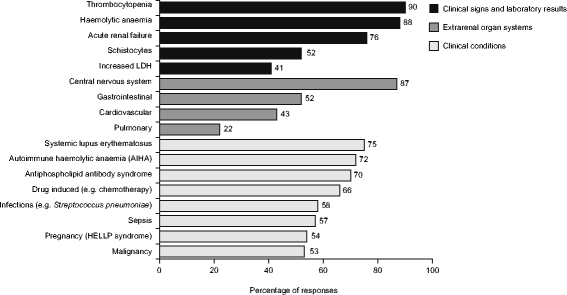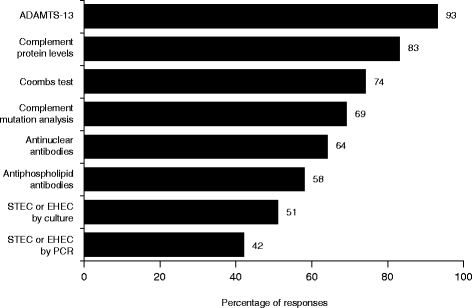Differential diagnosis of thrombotic microangiopathy in nephrology
- PMID: 29080561
- PMCID: PMC5660444
- DOI: 10.1186/s12882-017-0727-y
Differential diagnosis of thrombotic microangiopathy in nephrology
Abstract
Background: The differential diagnosis of thrombotic microangiopathy (TMA) is complex however the rapid diagnosis of the underlying condition is vital to inform urgent treatment decisions. A survey was devised with the objective of understanding current practices across Europe and the Middle East, and of challenges when diagnosing the cause of TMA.
Methods: Over 450 clinicians, from 16 countries were invited to complete an online survey.
Results: Of 254 respondents, the majority were nephrologists, had >10 years' experience in their specialty, and had diagnosed a patient with TMA. The triad of thrombocytopenia, haemolytic anaemia and acute kidney injury are the main diagnostic criteria used. Responses indicate that a differential diagnosis of TMA is usually made within 1-2 (53%) or 3-4 days (26%) of presentation. Similarly, therapy is usually initiated within the first 4 days (74%), however 13% report treatment initiation >1-week post-presentation. Extrarenal symptoms and a panoply of other conditions are considered when assessing the differential diagnosis of TMA. While 70 and 78% of respondents stated they always request complement protein levels and ADAMTS13 activity, respectively. Diagnostic considerations of paediatric and adult nephrologists varied. A greater proportion of paediatric than adult nephrologists consider extrarenal manifestations clinically related to a diagnosis of TMA; pulmonary (45% vs. 18%), gastrointestinal (67% vs. 50%), CNS (96% vs. 84%) and cardiovascular (54% vs. 42%), respectively. Variability in the availability of guidelines and extent of family history taken was also evident.
Conclusions: This survey reveals the variability of current practices and the need for increased urgency among physicians in the differential diagnosis of TMA, despite their experience. Above all, the survey highlights the need for international clinical guidelines to provide systematically developed recommendations for understanding the relevance of complement protein levels, complement abnormalities and ADAMTS13 testing, in making a differential diagnosis of TMA. Such clinical guidelines would enable physicians to make a more rapid and informed diagnosis of TMA, therefore initiate effective treatment earlier, with a consequent improvement in patient outcomes.
Keywords: AKI; Complement; Haemolytic anaemia; Kidney diseases; Survey; TMA; TTP; Thrombocytopenia; aHUS.
Conflict of interest statement
Ethics approval and consent to participate
Ethical approval was not required as the manuscript does not contain any clinical studies or patient data. Consent to participate was implied if the respondent completed the survey.
Consent for publication
Not applicable.
Competing interests
All authors have received honoraria, travel and accommodation expenses from Alexion Pharma GmbH. CG is an employee and shareholder of Alexion Pharma, GmbH.
Publisher’s Note
Springer Nature remains neutral with regard to jurisdictional claims in published maps and institutional affiliations.
Figures



References
MeSH terms
Substances
LinkOut - more resources
Full Text Sources
Other Literature Sources

